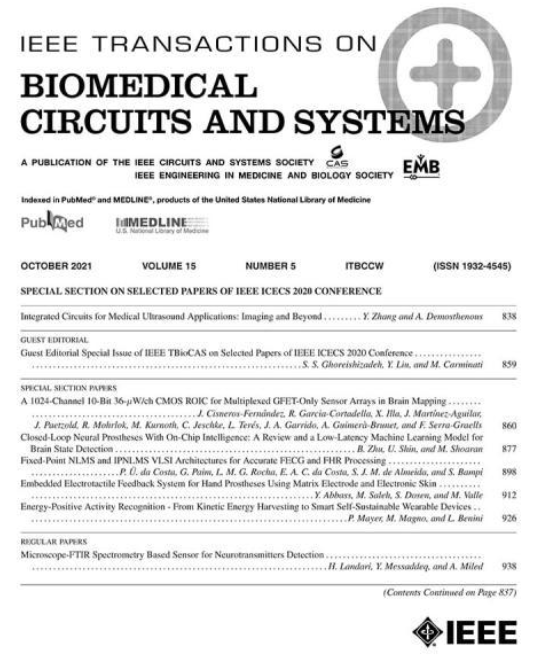识别咳嗽声音的深度神经网络
IF 4.9
2区 医学
Q2 ENGINEERING, BIOMEDICAL
IEEE Transactions on Biomedical Circuits and Systems
Pub Date : 2016-09-16
DOI:10.1109/TBCAS.2016.2598794
引用次数: 98
摘要
在本文中,我们考虑了使用深度神经网络进行咳嗽检测的两种不同方法。咳嗽检测任务被视为一个视觉识别问题和一个序列到序列的标记问题。分别实现了卷积神经网络和递归神经网络来解决这些问题。我们评估了这两个网络的性能,并将它们与其他识别咳嗽声音的传统方法进行了比较。此外,我们还探讨了网络大小参数和长期信号依赖对咳嗽分类器性能的影响。实验结果表明,这两种网络结构都优于传统方法。在两者之间,我们的卷积网络产生更高的特异性92.7%,而复发达到更高的敏感性87.7%。本文章由计算机程序翻译,如有差异,请以英文原文为准。
Deep Neural Networks for Identifying Cough Sounds
In this paper, we consider two different approaches of using deep neural networks for cough detection. The cough detection task is cast as a visual recognition problem and as a sequence-to-sequence labeling problem. A convolutional neural network and a recurrent neural network are implemented to address these problems, respectively. We evaluate the performance of the two networks and compare them to other conventional approaches for identifying cough sounds. In addition, we also explore the effect of the network size parameters and the impact of long-term signal dependencies in cough classifier performance. Experimental results show both network architectures outperform traditional methods. Between the two, our convolutional network yields a higher specificity 92.7% whereas the recurrent attains a higher sensitivity of 87.7%.
求助全文
通过发布文献求助,成功后即可免费获取论文全文。
去求助
来源期刊

IEEE Transactions on Biomedical Circuits and Systems
工程技术-工程:电子与电气
CiteScore
10.00
自引率
13.70%
发文量
174
审稿时长
3 months
期刊介绍:
The IEEE Transactions on Biomedical Circuits and Systems addresses areas at the crossroads of Circuits and Systems and Life Sciences. The main emphasis is on microelectronic issues in a wide range of applications found in life sciences, physical sciences and engineering. The primary goal of the journal is to bridge the unique scientific and technical activities of the Circuits and Systems Society to a wide variety of related areas such as: • Bioelectronics • Implantable and wearable electronics like cochlear and retinal prosthesis, motor control, etc. • Biotechnology sensor circuits, integrated systems, and networks • Micropower imaging technology • BioMEMS • Lab-on-chip Bio-nanotechnology • Organic Semiconductors • Biomedical Engineering • Genomics and Proteomics • Neuromorphic Engineering • Smart sensors • Low power micro- and nanoelectronics • Mixed-mode system-on-chip • Wireless technology • Gene circuits and molecular circuits • System biology • Brain science and engineering: such as neuro-informatics, neural prosthesis, cognitive engineering, brain computer interface • Healthcare: information technology for biomedical, epidemiology, and other related life science applications. General, theoretical, and application-oriented papers in the abovementioned technical areas with a Circuits and Systems perspective are encouraged to publish in TBioCAS. Of special interest are biomedical-oriented papers with a Circuits and Systems angle.
 求助内容:
求助内容: 应助结果提醒方式:
应助结果提醒方式:


